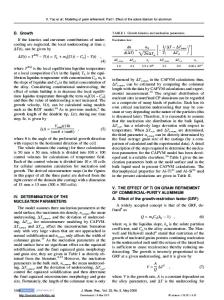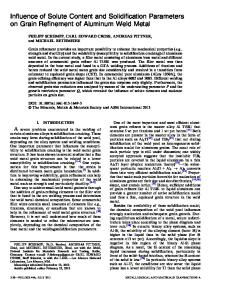The role of solute in grain refinement of magnesium
- PDF / 1,554,960 Bytes
- 12 Pages / 612 x 792 pts (letter) Page_size
- 77 Downloads / 411 Views
I. INTRODUCTION
WORLD production of magnesium, the eighth most common element in the earth’s crust, has increased continuously since the first production in 1808. The use of magnesium, and hence the associated research activity, greatly increased during the Second World War because of demand generated by military applications. Recently, the demand for magnesium alloys has again increased rapidly owing to increased efforts by the automotive industry to adopt light materials in order to achieve improved fuel economy and lower emission levels. According to a recent industry review,[1] there are 60 different types of components, from instrument panels to engine components, in which magnesium is used or is being developed for use, and the use of magnesium in automobile parts is predicted to increase globally at an average rate of 15 pct per year. Grain size is one of the most important factors determining the quality of cast metal products because it significantly affects the mechanical properties. The grain size of castings can be manipulated by altering various casting parameters, such as the cooling rate, or by adding alloying elements and nucleants (a grain refiner) before or during the casting process. Much work has been performed to achieve control of grain size of most cast metal products, including magnesium alloys. The significant amount of research on magnesium alloys is not because these alloys have a tendency to exhibit coarse grains compared to other cast metals, but because magnesium alloys have the potential to produce much finer grains than do most other alloys.[2] Unlike aluminum alloys, where well-established, reliable grain refiners are commercially available, a similar universally reliable grain refiner system does not exist for the range of magnesium alloys. Because of the importance of grain refinement to the development of high-performance magnesium alloys, a study was initiated to improve understanding
Y.C. LEE, Graduate Student, A.K. DAHLE, Senior Lecturer, and D.H. StJOHN, Professor, are with the CRC for Cast Metals Manufacturing (CAST), Department of Mining, Minerals and Materials Engineering, The University of Queensland, Brisbane Qld 4072, Australia. Manuscript submitted October 26, 1999. METALLURGICAL AND MATERIALS TRANSACTIONS A
of the factors controlling grain refinement. This article presents initial work that has focused on the effect of solute additions. A literature review is also presented that sets the context of the current knowledge of grain refinement in magnesium alloys. Experiments that add to available data on the effect of solute elements on grain size have been conducted and analyzed.
Grain Refinement Methods for Mg Alloys 1. Superheating This process consists of heating the melt to a temperature well above the melting point for a short time, and then cooling it back to the pouring temperature. The required superheating temperature for successful grain refinement is dependent on the alloy composition, but is commonly accepted to be about 150 8C to 260 8C above the liquid
Data Loading...











